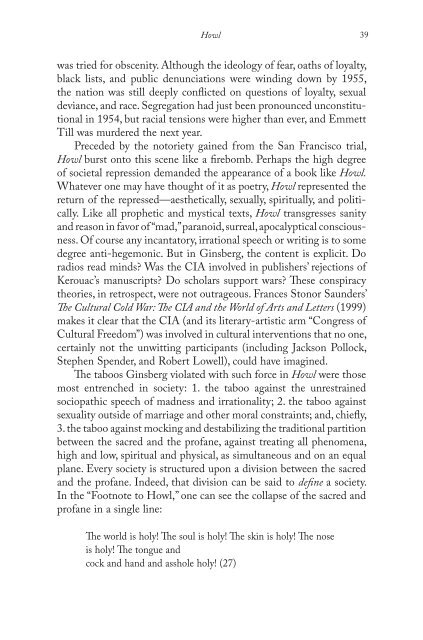Bloom's Literary Themes - ymerleksi - home
Bloom's Literary Themes - ymerleksi - home
Bloom's Literary Themes - ymerleksi - home
Create successful ePaper yourself
Turn your PDF publications into a flip-book with our unique Google optimized e-Paper software.
Howl 39<br />
was tried for obscenity. Although the ideology of fear, oaths of loyalty,<br />
black lists, and public denunciations were winding down by 1955,<br />
the nation was still deeply conflicted on questions of loyalty, sexual<br />
deviance, and race. Segregation had just been pronounced unconstitutional<br />
in 1954, but racial tensions were higher than ever, and Emmett<br />
Till was murdered the next year.<br />
Preceded by the notoriety gained from the San Francisco trial,<br />
Howl burst onto this scene like a firebomb. Perhaps the high degree<br />
of societal repression demanded the appearance of a book like Howl.<br />
Whatever one may have thought of it as poetry, Howl represented the<br />
return of the repressed—aesthetically, sexually, spiritually, and politically.<br />
Like all prophetic and mystical texts, Howl transgresses sanity<br />
and reason in favor of “mad,” paranoid, surreal, apocalyptical consciousness.<br />
Of course any incantatory, irrational speech or writing is to some<br />
degree anti-hegemonic. But in Ginsberg, the content is explicit. Do<br />
radios read minds? Was the CIA involved in publishers’ rejections of<br />
Kerouac’s manuscripts? Do scholars support wars? These conspiracy<br />
theories, in retrospect, were not outrageous. Frances Stonor Saunders’<br />
The Cultural Cold War: The CIA and the World of Arts and Letters (1999)<br />
makes it clear that the CIA (and its literary-artistic arm “Congress of<br />
Cultural Freedom”) was involved in cultural interventions that no one,<br />
certainly not the unwitting participants (including Jackson Pollock,<br />
Stephen Spender, and Robert Lowell), could have imagined.<br />
The taboos Ginsberg violated with such force in Howl were those<br />
most entrenched in society: 1. the taboo against the unrestrained<br />
sociopathic speech of madness and irrationality; 2. the taboo against<br />
sexuality outside of marriage and other moral constraints; and, chiefly,<br />
3. the taboo against mocking and destabilizing the traditional partition<br />
between the sacred and the profane, against treating all phenomena,<br />
high and low, spiritual and physical, as simultaneous and on an equal<br />
plane. Every society is structured upon a division between the sacred<br />
and the profane. Indeed, that division can be said to define a society.<br />
In the “Footnote to Howl,” one can see the collapse of the sacred and<br />
profane in a single line:<br />
The world is holy! The soul is holy! The skin is holy! The nose<br />
is holy! The tongue and<br />
cock and hand and asshole holy! (27)
















